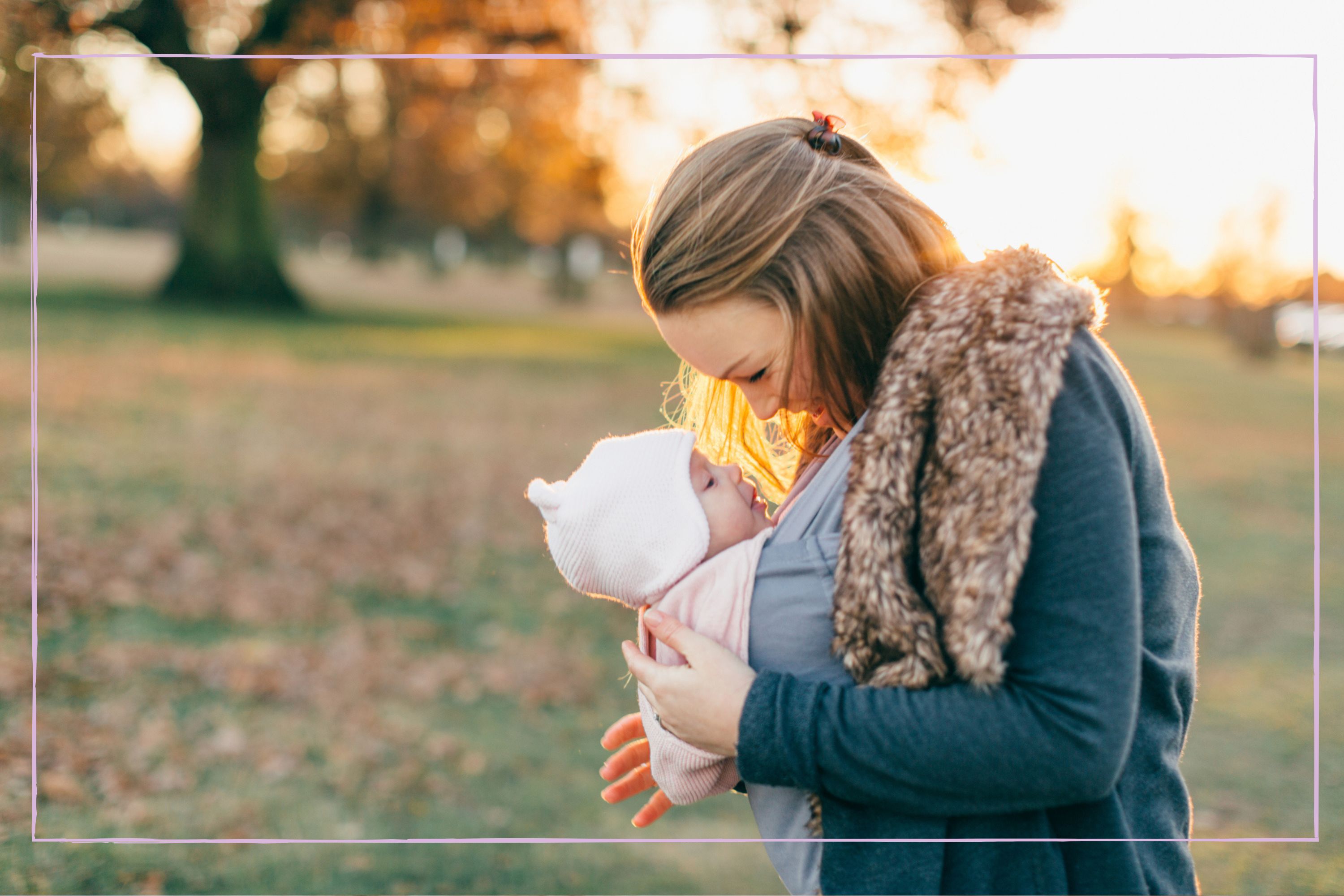What is attachment parenting and is it a style you want to try? We spoke to an expert and here’s all you need to know
Breaking down this popular parenting theory that promotes strong attachment between a parent and their baby


Dr Patricia Britto
Attachment parenting centres around adopting a constant physical closeness to your baby and being very responsive to their needs. Although evidence suggests the method does result in secure attachments, some criticisms come with adopting it - here's what you need to know.
Not to be confused with therapeutic parenting, the concept of attachment parenting began in the 1980s and was developed by an American paediatrician and his wife. William and Martha Sears believed modern life had caused parents to become emotionally detached from their children. The pair built a parenting method designed for parents to display loving and responsive interaction that would consciously rebuild attachments they considered lost from the family unit.
Note from our editor
While you might feel pressure to pick one parenting style, the reality is that you become a parent in an instant, but the act of parenting is a journey that's always on and evolving as you and your child grow. Discovering what parenting approach you want to adopt can take time and might change as you learn. There really is no one-size-fits-all approach. Your parenting style can change based on the evolving needs of your family life.
By responding quickly to your baby’s needs, part of the theory behind the attachment parenting model suggests little ones will be shielded from negative emotions such as fear and distress. It really does sit at the other end of the scale to tiger parenting.
Educational Psychologist Dr Patricia Britto, explains just how different attachment parenting looks. She tells us; "Attachment parenting allows parents to see their children as a separate person. This tends to make them feel that their children don't owe them anything, which enables realistic expectations. Parents who use the attachment parenting approach can also be more attuned to the child’s needs, empathise and validate their emotions and be present. In turn, this allows children who are securely attached to trust others outside of their family, maintain a unique sense of identity, while still being able to connect with others."
Whether you’re a helicopter parent or a gentle parent, there can be difficulty in deciding which style is for you. This article will outline what attachment parenting is and what attachment parenting styles are. To let you decide whether it’s a good fit for your family, we’ll look at the downsides and signpost you to experts offering more information on attachment parenting.
What is attachment parenting?
Attachment parenting involves constant physical closeness to your baby, such as 'baby wearing' and being very responsive to their needs. It also believes that all behaviour is communication. This style is informed by the attachment theory pioneered by British psychologist John Bowlby. He believed that early bonds babies formed with parental figures had a lifelong lasting impact. While some behavioural theorists believed attachment was a learned process, Bowlby believed children are born with a natural drive to form secure attachments.
Attachment parenting suggests that babies who form secure attachments, become independent adults able to form and continue to maintain secure relationships. The proposed approaches to forming an attachment with your baby are to keep them close to you - frequent holding and the use of slings helps this closeness, which can be skin-to-skin when able.
Parenting advice, hot topics, best buys and family finance tips delivered straight to your inbox.
Attachment parents often co-sleep and breastfeed on demand, believing that they shouldn’t impose feeding schedules on their little ones. Instead, all feeding should be baby-led. Being so close to their babies facilitates the level of responsiveness required for attachment parenting, with parents becoming highly attuned to their baby’s emotions and freeing them from negative feelings by soothing them quickly.
Dr Britto told us, "The benefits of attachment parenting involve a positive relationship and bond between a child and primary caregiver. The attachments children form with their primary caregivers in their early relationships can also impact their feelings of security, safety, confidence and satisfaction in other relationships as they develop into adults. Children with a secure attachment often see their caregivers as a secure base from which they can venture out from and explore the world. They feel they can move freely, but equally are confident that they can always come back to their parents to feel safe."
What are the attachment parenting styles?
Studies show there to be four styles of infant-parent attachment. These are secure, avoidant, resistant and disorganised. The quality and category of attachment is thought to be determined by the caregiver’s responsiveness when their baby’s attachment system is in the process of activation.
Secure
Babies whose parents respond to their distress in a sensitive and loving manner, feel secure enough in their attachment to express negative emotion. Those picked up quickly and offered rapid reassurance, know they have a safe person to express their distress to - they’re secure in the knowledge they will receive help. Their organised and secure method to deal with negative emotions is to seek proximity and contact with the person who makes them feel safe - they learn to elicit the sensitive response they need when distressed.
Avoidant
Little ones with parents who consistently respond to their distress negatively, display avoidance of those caregivers when distressed, and minimise outward displays of negative emotion. Parents responding negatively includes ignoring their distressed child, ridiculing or being angry with them. By avoiding the parent. the baby displays an organised strategy of learnt behaviour - they deliberately avoid the caregiver when they need them the most.
Resistant
Similarly, parents who respond to infant distress in inconsistent and unpredictable ways, can have babies who display extreme negative emotion to get the attention they need. When they become used to inconsistent responses from a primary carer, exaggerated displays of distress and resistant responses can ensue from a little one, in the hope their emotional needs will be met. Such a resistant and insecure strategy has been associated with increased risks relating to social and emotional maladjustment.
Disorganised
A large percentage of children from high psychosocial risk families, do not use any of the three organised strategies for dealing with stress. Instead of being secure, avoidant or resistant in their attachment, they are considered to have disorganised attachment. Parents of children with disorganised attachment respond atypically to their child’s needs, in ways said to be frightening or dissociated. Their response behaviours are often not limited to when their child is distressed, but can spread to every interaction. Commonly, parents who behave in this way have a history of emotional, physical or sexual trauma, or have been left traumatised by events such as domestic violence.
What are the downsides of attachment parenting?
Although there are plenty of positives relating to attachment parenting, Dr Britto concurs "Like any theoretical concepts there are pros and cons to attachment parenting." For example, NHS advice around bed-sharing has been updated to reflect that many parents want to try it, there are still risks involving potential SIDS (sudden infant death syndrome) that need to be adequately assessed if co-sleeping. If attachment parents are going to co-sleep with their baby long term, they should seek advice from the Lullaby Trust or their own healthcare provider, to be sure they minimise risks to their child.
What our writer learned
From the research carried out for this article and speaking to experts, it's easy to see the enormous benefits of attachment parenting. I was certainly a fan of carrying my babies in slings for ease and keeping them close as they both struggled to settle. However, as a lousy sleeper before becoming a parent, co-sleeping made this even worse. I also experienced a need to have my own space and not have the baby with me at all times. Although some parents will adore this closeness, it definitely won't be for all - and that's fine too.
It has also been suggested the concept places a lot of pressure on parents, especially mothers. With mothers expected to put their own space, sleep schedules and ability to be intimate to one side, attachment parenting can potentially be draining. Some have even called the practice anti-feminist, as it can also hinder a mother’s ability to return to work and force her to stay at home for longer than she might like.
A sense of failure could be possible if a mother can’t continue to breastfeed and her baby requires formula, or if the methods involved in the attachment parenting style do become overwhelming and need to be reconsidered. By not following through on the principles of attachment parenting, some parents might feel a level of fear.
Dr Britto concluded that not all parents choose to adopt every principle of attachment parenting, and advocates of the style agree that it can be adapted for parental needs if necessary. Dr Britto told us that just being available to your child can be enough, adding "Over time, children reassured of the availability of their parents; even when not visible, know they will return, which is the comfort they need."
Where to find additional help with parenting styles
- The National Childbirth Trust has information on parenting styles and how to identify yours.
- Parenting Styles has a full overview of styles available, along with case studies, and experts on hand to answer your questions.
- The Government paper Helping Parents to Parent has advice on parenting styles.
- If you’re looking specifically for advice on attachment parenting, Attachment Parenting UK offers mentoring, courses and other resources for this particular style.

Dr. Patricia Britto is a qualified Educational Psychologist (HCPC Registered) and a mother with practical and research experience. Her qualifications include a Doctorate in Professional Educational, Child and Adolescent Psychology (DEdPsy) from UCL, Institute of Education, an MSc in Mental Health in Learning Disabilities and a BSc in Psychology.
Once the baby days are over, it's time to consider how to navigate the teenage years - reflective parenting is said to help your teen manage their emotions. There's also a need to know what to expect when your teen starts dating, and arm yourself with conversation starters to get them to open up to you about what's going on in their lives - we have some invaluable advice on these topics.

Lucy is a mum-of-two, multi-award nominated writer and blogger with six years’ of experience writing about parenting, family life, and TV. Lucy has contributed content to PopSugar and moms.com. In the last three years, she has transformed her passion for streaming countless hours of television into specialising in entertainment writing. There is now nothing she loves more than watching the best shows on television and sharing why you - and your kids - should watch them.
- Dr Patricia BrittoEducational Psychologist (HCPC Registered)